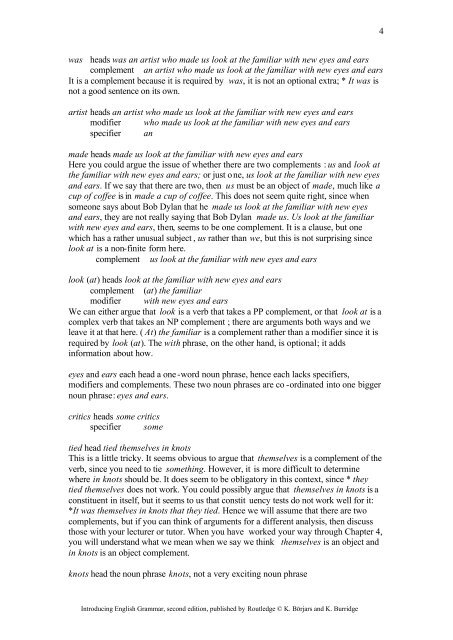Answers to exercises: Chapter 3
Answers to exercises: Chapter 3
Answers to exercises: Chapter 3
Create successful ePaper yourself
Turn your PDF publications into a flip-book with our unique Google optimized e-Paper software.
4was heads was an artist who made us look at the familiar with new eyes and earscomplement an artist who made us look at the familiar with new eyes and earsIt is a complement because it is required by was, it is not an optional extra; * It was isnot a good sentence on its own.artist heads an artist who made us look at the familiar with new eyes and earsmodifier who made us look at the familiar with new eyes and earsspecifier anmade heads made us look at the familiar with new eyes and earsHere you could argue the issue of whether there are two complements : us and look atthe familiar with new eyes and ears; or just one, us look at the familiar with new eyesand ears. If we say that there are two, then us must be an object of made, much like acup of coffee is in made a cup of coffee. This does not seem quite right, since whensomeone says about Bob Dylan that he made us look at the familiar with new eyesand ears, they are not really saying that Bob Dylan made us. Us look at the familiarwith new eyes and ears, then, seems <strong>to</strong> be one complement. It is a clause, but onewhich has a rather unusual subject , us rather than we, but this is not surprising sincelook at is a non-finite form here.complement us look at the familiar with new eyes and earslook (at) heads look at the familiar with new eyes and earscomplement (at) the familiarmodifier with new eyes and earsWe can either argue that look is a verb that takes a PP complement, or that look at is acomplex verb that takes an NP complement ; there are arguments both ways and weleave it at that here. ( At) the familiar is a complement rather than a modifier since it isrequired by look (at). The with phrase, on the other hand, is optional; it addsinformation about how.eyes and ears each head a one -word noun phrase, hence each lacks specifiers,modifiers and complements. These two noun phrases are co -ordinated in<strong>to</strong> one biggernoun phrase: eyes and ears.critics heads some criticsspecifier sometied head tied themselves in knotsThis is a little tricky. It seems obvious <strong>to</strong> argue that themselves is a complement of theverb, since you need <strong>to</strong> tie something. However, it is more difficult <strong>to</strong> determinewhere in knots should be. It does seem <strong>to</strong> be obliga<strong>to</strong>ry in this context, since * theytied themselves does not work. You could possibly argue that themselves in knots is aconstituent in itself, but it seems <strong>to</strong> us that constit uency tests do not work well for it:*It was themselves in knots that they tied. Hence we will assume that there are twocomplements, but if you can think of arguments for a different analysis, then discussthose with your lecturer or tu<strong>to</strong>r. When you have worked your way through <strong>Chapter</strong> 4,you will understand what we mean when we say we think themselves is an object andin knots is an object complement.knots head the noun phrase knots, not a very exciting noun phraseIntroducing English Grammar, second edition, published by Routledge © K. Börjars and K. Burridge
















